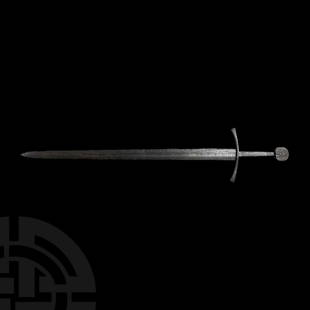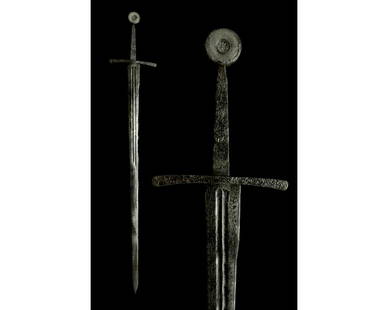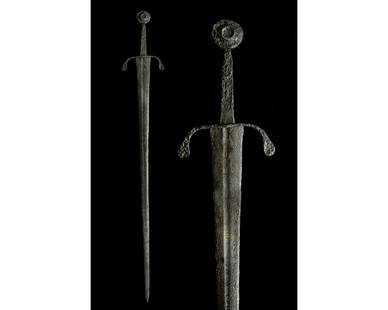
Medieval Double-Handed Sword with Inlaid Pommel
Similar Sale History
View More Items in Weapons & ArmorRelated Weapons & Armor
More Items in Weapons & Armor
View MoreRecommended Collectibles
View More


Item Details
Description
Early 13th century AD. An iron longsword of Oakeshott's Type XIIIA, cross style 1, pommel type H; a 'Bastard' sword (sword that can also be used with two hands), with long tapering blade, cutting edges running nearly parallel to the tip; just below the hilt, before the edges begin their virtual straight running to the point, the blade is swelling slightly in width; the narrow fullers extended for two-thirds of its length; the lower guard is simple and straight; the grip is longer than usual of type XIII allowing for the off-hand to be used for extra leverage and power; the pommel is highly decorated with two different inlays, from one side a circular space divided in eight sections, the other side with a possible heraldic symbol, representing a triangular shield decorated with embossed annulets surmounting a kantharos from which water is springing; both images are inscribed inside a golden circle; some corrosions on the lower edges but no evidence of traces of fighting nicks, both cutting edges are well preserved; German or English manufacture. See Petersen, J., De Norske Vikingsverd, Oslo, 1919; Shetelig, H., Scandinavian Archaeology, Oxford, 1937; Oakeshott, E.,The archaeology of the weapons, arms and armours from Prehistory to the age of Chivalry, Woodbridge, 1960 (1999); Oakeshott, E., The sword in the Age of the Chivalry, Woodbridge, 1964 (1994); Oakeshott, E., Records of the Medieval Sword, Woodbridge, 1991; the sword, belongs to the type of 'war sword' and finds a good correspondence with various swords of the first half of the 14th century, like some specimens preserved in the Museum Art Gallery of Glasgow (Oakeshott, 1991, pp.103 n.7; 105, nn.10-11); for what concern the cross-guard, it is of a simple and obvious form, a straight bar tapering slightly toward the ends; first found in Viking graves of the 10th century (s. Shetelig, 1937), and called by the Vikings Gaddhjalt (Spike-Hilt, s. Petersen, 1919), it was still in use in the Renaissance (Oakeshott, 1994, p.113 and plates IC, 6A and 46B), generally square in section, it may sometimes be circular, or in rare, late cases octagonal; pommel forms vary very often on the survival specimens, though the wheel shape from H to K predominate; crosses both on surviving example and those shown in the art are nearly always straight, generally of type 1 or 2; there are some excellent pictures of these swords in an English manuscript of the early years of the fourteenth century (B.M. MS. Roy. 19.B.XV, an Apocalypse of St. John (Oakeshott, 1994, fig.89-90); nearly every German military tomb effigy of the period between about 1280-1350 AD has one of these big swords and several are shown on English effigies, as for instance at Astbury in Cheshire; one very good example on an English tomb is difficult to see—a little mounted figure high up on the canopy of Edmund Crouchback's tomb in Westminster Abbey; Edmund was the Earl of Lancaster, second son of Henry III, and died in 1296. It is possible to see it if you climb up into the Islip Chapel in the North Choir aisle, for this is raised about 30 ft. above the level of the floor; look across the aisle over the parapet of the chapel which spans the arch containing it and there is this small knight with a great war sword girt to his waist (Oakeshott,1994, fig.92); another of an earlier date is to be found in an admirable little drawing of a knight fighting a giant upon a page of a small Psalter made for the eldest son of Edward I of England, Alphonso, who died in 1284 (Oakeshott, 1994, fig.91"). 1.3 kg, 1.03m (40 1/2"). From an important private family collection of arms and armour; acquired on the European art market in the 1980s, and thence by descent; accompanied by an academic report by military specialist Dr Raffaele D'Amato. A long double-handed sword, Oakeshott type XIIIa; the most beautiful element of this sword is its decorative pommel, of type H in the Oakeshott classification (Oakeshott, 1994, p.95"). This is one of the commonest of all medieval pommels, where the edges of the disc are chamfered off on each face, giving a low prominence on either side, the inner, flat faces being about a quarter less in diameter than the outer rim. It is found on swords of every type from the 10th century until the early 15th century AD, and after three-quarters of a century of apparent unpopularity it appears again, rarely, between c.1500-1525. What is extraordinary is not the pommel in itself, but the inlaid decoration over it. The shield with annulets ('little rings' in heraldry) visible on one side is a common charge, which may allude to the custom of the prelates to receive their investiture per baculum et annulum i.e. 'by rod and by ring', and can also be described as a roundel that has been 'voided' (ie. with its centre cut out"). In medieval English heraldry, annulets could represent a fifth son. The shield is surmounted by a pot from which water is springing, an obvious connection with the biblical passage: 'Jesus answered: Everyone who drinks this water will be thirsty again, but whoever drinks the water I give them will never thirst. Indeed, the water I give them will become in them a spring of water welling up to eternal life'' (John, IV,13-14"). The solar disc on the other side of the pommel evokes Christ's ancient monogram. These references to Christian symbolism suggest that the owner of the sword was an clergyman, maybe the fifth son of an aristocratic English family.
Condition
Fine condition. Very rare.
Buyer's Premium
- 30%
Medieval Double-Handed Sword with Inlaid Pommel
Estimate £5,000 - £7,000
13 bidders are watching this item.
Shipping & Pickup Options
Item located in London, ukSee Policy for Shipping
Payment

TOP



































![[SWORDS OR SABERS]. Sabre du Sappeur de la Garde Impériale....: [SWORDS OR SABERS]. Sabre du Sappeur de la Garde Impériale. [France, ca. 1812]. This weapon is one of the most visually stunning sabres of the French Army under Napoleon. Whole length of sword an](https://p1.liveauctioneers.com/928/328184/176813537_1_x.jpg?height=310&quality=70&version=1714496988)



![[SWORDS OR SABERS]. Sabre du Imperiale Hussards - Light Cal...: [SWORDS OR SABERS]. Sabre du Imperiale Hussards - Light Cavalry. [France, ca. 1812]. Saber of the Imperial Hussards - Light Cavalry Officer. Somewhat in the style of Mameluke/Arabic style. With chain](https://p1.liveauctioneers.com/928/328184/176813540_1_x.jpg?height=310&quality=70&version=1714496988)
![[SWORDS OR SABERS]. Sabre de Troupe des Marins. [France, ca...: [SWORDS OR SABERS]. Sabre de Troupe des Marins. [France, ca. 1800s-1820s]. This very rare Marin Sabre is the model for the Troupe du Marins de la Garde, with the original wire bound leather grip, bras](https://p1.liveauctioneers.com/928/328184/176813539_1_x.jpg?height=310&quality=70&version=1714496988)
































![George Washington Signed Discharge: Partly printed discharge document signed by George Washington, as Commander in Chief of the Armies of the United States. Newburgh, [New York], 4 January 1783. 1 page, ## x ## in. Undersigned by Washin](https://p1.liveauctioneers.com/7226/322253/173251475_1_x.jpg?height=310&quality=70&version=1710004847)
![[Ambrotype] Texas Confederate Soldier: Sixth plate ambrotype. Full leatherette case. Portrait of a possible Texas Confederate soldier. A silver star device was used to pin up the brim of his light-toned headgear, a look often seen in image](https://p1.liveauctioneers.com/7226/322253/173251509_1_x.jpg?height=310&quality=70&version=1710004847)


![Captured Bowie Knife w/ Period Note of Provenance: Captured Confederate D-hilt Bowie knife. [Kenansville, North Carolina]: [Louis Froelich factory]. With original metal and leather sheath with affixed period notes. First note with only remnants. Secon](https://p1.liveauctioneers.com/7226/325455/175169154_1_x.jpg?height=310&quality=70&version=1712370394)
